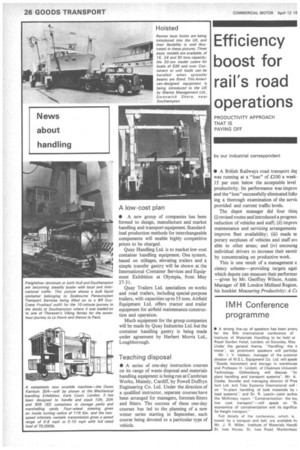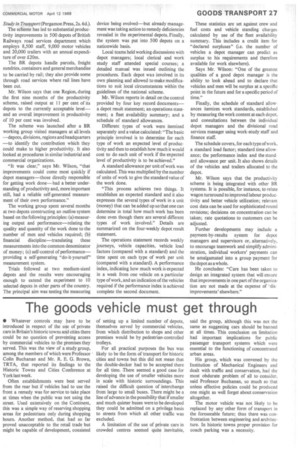Efficiency boost for rail's road operations
Page 28

Page 29

If you've noticed an error in this article please click here to report it so we can fix it.
PRODUCTIVITY APPROACH THAT IS
PAYING OFF by our industrial correspondent • A British Railways road transport der was running at a "loss" of £200 a week15 per cent below the acceptable level productivity. Its performance was irnprov and the "loss" successfully eliminated follo ing a thorough examination of the servic provided and current traffic levels.
The depot manager did four thint (i) revised routes and introduced a progress reduction of vehicles and staff; (ii) improv maintenance and servicing arrangements improve fleet availability; (iii) made te porary surpluses of vehicles and staff avt able to other areas; and (iv) encourag individual drivers to increase their earnir by concentrating on productive work.
This is one result of a management e ciency scheme—providing targets agai; which depots can measure their performar —given by Mr. Geoffrey Wilson, Assist; Manager of BR London Midland Region, his booklet Measuring Productivity: A Cc
Study in Transport (Pergamon Press, 2s. 6d.).
The scheme has led to substantial productivity improvements in 500 depots of British Railways road services department which employs 8,500 staff, 9,000 motor vehicles and 20,000 trailers with an annual expenditure of over £20m.
The BR depots handle parcels, freight sundries, containers and general merchandise to be carried by rail; they also provide some through road services where rail lines have been cut.
Mr. Wilson says that one Region, during the first nine months of the productivity scheme, raised output at 11 per cent of its depots to the currently acceptable level— and an overall improvement in productivity of 10 per cent was involved.
The scheme was launched after a BR working group visited managers at all levels — depots, divisions, regions and headquarters — to identify the contribution which they could make to higher productivity. It also looked at procedures in similar industrial and commercial organizations.
"It was clear," says Mr. Wilson, "that improvements could come most quickly if depot managers—those directly responsible for getting work done—had a better understanding of productivity and, more important still, had a reliable self-generated measurement of their own performance."
The working group spent several months at two depots constructing an outline system based on the following principles: (a) measuring output and performance—relating the quality and quantity of the work done to the number of men and vehicles required; (b) financial discipline—translating these measurements into the common denominator of money; (c) self-control of performance— providing a self-generating "do-it-yourselr' measurement system.
Trials followed at two medium-sized depots and the results were encouraging enough to extend the experiment to 10 selected depots in other parts of the country. The principal aim was testing the measuring device being evolved—but already management was taking action to remedy deficiencies revealed in the experimental depots. Finally, the system was put into 500 depots on a nationwide basis.
Local teams held working discussions with depot managers; local clerical and work study staff attended special courses; a detailed manual was issued outlining the procedures. Each depot was involved in its own planning and allowed to make modifications to suit local circumstances within the guidelines of the national scheme.
Mr. Wilson reports in detail on the control provided by four key record documents ---a depot result statement; an operations statement; a fleet availability summary; and a schedule of standard allowances.
Different types of work were itemized separately and a value calculated: "The basic principle involved is to determine for each type of work an expected level of productivity and then to establish how much it would cost to do each unit of work if the expected level of productivity is to be achieved."
A standard allowance per unit of work was calculated. This was multiplied by the number of units of work to give the standard value of the work done.
"This process achieves two things. It establishes an expected standard and it also expresses the several types of work in a unit (money) that can be added up so that one can determine in total how much work has been done even though there are several different types of work involved." Details are summarized on the four-weekly depot result statement.
The operations statement records weekly journeys, vehicle capacities, vehicle load factors (compared with a standard) and the time spent on each type of work per unit (compared with a standard). A performance index, indicating how much work is expected in a week from one vehicle on a particular type of work, and an indication of the vehicles required if the performance index is achieved complete the second document. These statistics are set against crew and fuel costs and vehicle standing charges calculated by use of the fleet availability summary. This includes a credit item for "declared surpluses" (i.e. the number of vehicles a depot manager can predict as surplus to his requirements and therefore available for work elsewhere).
Says Mr. Wilson: "One of the greatest qualities of a good depot manager is the ability to look ahead and to declare that vehicles and men will be surplus at a specific point in the future and for a specific period of time."
Finally, the schedule of standard allowances itemizes work standards, established by measuring the work content at each depot, and consultations between the individual depot managers and the divisional road services manager using work-study staff and finance staff.
The schedule covers, for each type of work, a standard load factor; standard time allowance; the performance index and the standard allowance per unit. It also shows details of the vehicles and trailers allocated to the depot.
Mr. Wilson says that the productivity scheme is being integrated with other BR systems. It is possible, for instance, to relate wagon turnround to improved labour productivity and better vehicle utilization; relevant cost data can be used for sophisticated round revisions; decisions on concentration can be taken; rate quotations to customers can be adjusted.
Further developments may include a payment-by-results system for depot managers and supervisors or, alternatively, to encourage teamwork and simplify administration, individual workers' payments can be amalgamated into a group payment for the depot as a whole.
He concludes: "Care has been taken to design an integrated system that will ensure that improvements in one part of the organ i zation are not made at the expense of `disimprovements ' elsewhere."




































































































